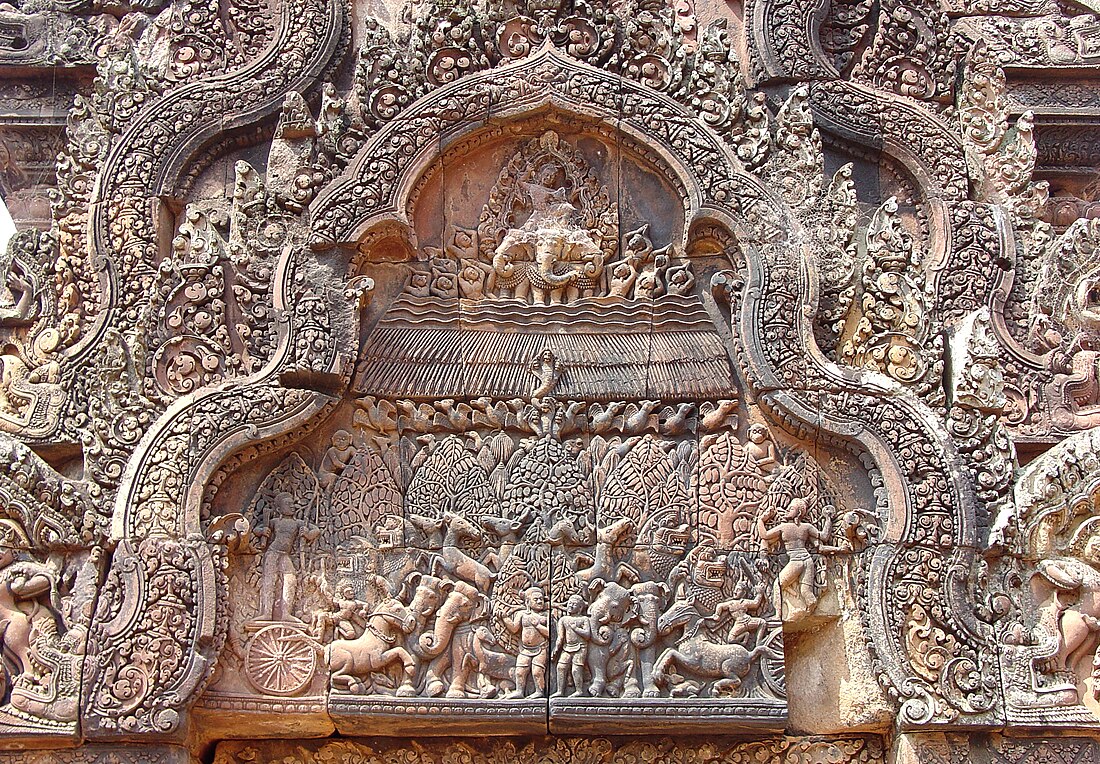Indraprastha
Ancient city in present-day Delhi, India From Wikipedia, the free encyclopedia
Indraprastha (Sanskrit: इन्द्रप्रस्थ, [in̪d̪ɾɐpɾɐst̪ʰə]) (lit. "Plain of Indra"[1] or "City of Indra") is a city cited in ancient Indian literature as a constituent of the Kuru Kingdom. It was designated the capital of the Pandavas, a brotherly quintet in the Hindu epic Mahabharata. The city is sometimes also referred to as Khandavaprastha or Khandava Forest, the epithet of a forested region situated on the banks of Yamuna river which, going by the Hindu epic Mahabharata, was cleared by Krishna and Arjuna to build the city.[2] Under the Pali form of its name, Indapatta, it is also mentioned in Buddhist texts as the capital of the Kuru Mahajanapada.
Indraprastha | |
|---|---|
| Khandavaprastha | |
top: burning of Khandava Forest to build Indraprastha (Mahabharata scene, as depicted at Banteay Srei) bottom: medieval fort Purana Qila built on the possible site of ancient Indraprastha | |
Location of Purana Qila, proposed as possible site of Indraprastha | |
| Coordinates: 28°36′34″N 77°14′39″E | |
| Country | India |
| State | Delhi |
| Current Name | Delhi |
| Founded by | Pandava |
| Named after | Indradev |
The topography of the medieval fort Purana Qila on the banks of the river Yamuna matches the literary description of the citadel Indraprastha in the Mahabharata; however, excavations in the area have revealed no signs of an ancient fortified city to match the epic's described grandeur, as only a limited quantity of Iron Age pottery shards were found, and some few artifacts and structural remains of Maurya to Kushan period settlements (see below). It must be remembered that coordinating material archaeological culture with bardic literature is methodologically almost always impossible.[3]
History
Summarize
Perspective
Indraprastha is referenced in the Mahabharata, an ancient Sanskrit text penned by the author Vyasa. It was one of the five places sought for the sake of peace, and, to avert a disastrous war, Krishna proposed that if Hastinapura consented to give the Pandavas only five villages, namely, Indraprastha, Svarnaprastha (Sonipat), Panduprastha (Panipat), Vyaghraprastha (Baghpat), and Tilaprastha (Tilpat),[4] then they would be satisfied and would make no more demands. Duryodhana vehemently refused, commenting that he would not part with land even as much as the point of a needle. Thus, the stage was set for the great war for which the epic of Mahabharata is known most of all. The Mahabharata records Indraprastha as being home to the Pandavas, whose wars with the Kauravas it describes.

In Pali Buddhist literature, Indraprastha was known as Indapatta. The location of Indraprastha is uncertain, but the Purana Qila in present-day New Delhi is frequently cited[a] and has been noted as such in texts as old as the 14th-century CE.[7] The modern form of the name, Inderpat, continued to be applied to the Purana Qila area into the early 20th century,[8][b] and the fort also was known as Pandavon Ka Qila (Pandava's fort).[10]
Location
Purana Qila is certainly an ancient settlement but archaeological studies performed there since the 1950s[c][d] have failed to reveal structures and artefacts that would confirm the architectural grandeur and rich lives in the period that the Mahabharata describes. The historian Upinder Singh notes that despite the academic debate, "Ultimately, there is no way of conclusively proving or disproving whether the Pandavas or Kauravas ever lived ...".[7] However, it is possible that the main part of the ancient city has not been reached by excavations so far, but rather falls under the unexcavated area extending directly to the south of Purana Qila.[e] Overall, Delhi has been the center of the area where the ancient city has historically been estimated to be. Until 1913, a village called Indrapat existed within the fort walls.[13] As of 2014, the Archaeological Survey of India is continuing excavation in Purana Qila.[14]
Historical significance
Summarize
Perspective
Indraprastha is not only known from the Mahabharata. It is also mentioned as "Indapatta" or "Indapattana" in Pali-language Buddhist texts, where it is described as the capital of the Kuru Kingdom,[15] situated on the Yamuna River.[16] The Buddhist literature also mentions Hatthinipura (Hastinapura) and several smaller towns and villages of the Kuru kingdom.[15] Indraprastha may have been known to the Greco-Roman world as well: it is thought to be mentioned in Ptolemy's Geography dating from the 2nd century CE as the city "Indabara", possibly derived from the Prakrit form "Indabatta", and which was probably in the vicinity of Delhi.[17] Upinder Singh (2004) describes this equation of Indabara with Indraprastha as "plausible".[18] Indraprastha is also named as a pratigana (district) of the Delhi region in a Sanskrit inscription dated to 1327 CE, discovered in Raisina area of New Delhi.[19]
D. C. Sircar, an epigraphist, believed Indraprastha was a significant city in the Mauryan period, based on analysis of a stone carving found in the Delhi area at Sriniwaspuri which records the reign of the Mauryan emperor Ashoka.[citation needed] Singh has cast doubt on this interpretation because the inscription does not actually refer to Indraprastha and although
"... a place of importance must certainly have been located in the vicinity of the rock edict, exactly which one it was and what it was known as, is uncertain."
-Singh[20]
Similarly, remains, such as an iron pillar, that have been associated with Ashoka are not indubitably so: their composition is atypical and the inscriptions are vague.[7]
See also
References
External links
Wikiwand - on
Seamless Wikipedia browsing. On steroids.




